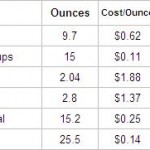I am pressed for time. Yeah, right, aren’t we all, but I do work outside the home, and I have a young daughter. I’d rather spend time reading her books than strapping her into the car for a long trip to the grocery or mall. I’ve significantly reduced my time at stores by using Amazon’s new Subscribe and Save program.
 I first found it while shopping for diapers. I can tell the store how often/how many packages I want and I never have to think of it again. If I’m running low, I can have the delivery sent early; if I have too much, I can delay or skip a shipment. It is intuitively customizable and can be changed at any time. As if that isn’t enough, there is always free shipping AND the item is 15% off of regular price. I’ve never bought a diaper in a brick and mortar store.
I first found it while shopping for diapers. I can tell the store how often/how many packages I want and I never have to think of it again. If I’m running low, I can have the delivery sent early; if I have too much, I can delay or skip a shipment. It is intuitively customizable and can be changed at any time. As if that isn’t enough, there is always free shipping AND the item is 15% off of regular price. I’ve never bought a diaper in a brick and mortar store.
After the success with diapers, I added more and more subscriptions for items I use frequently, from detergent that’s hard to find locally to nutritious whole grains for my baby. I currently subscribe to 14 different items.
 As for prices, I have (of course) created a spreadsheet to calculate the prices versus the regular grocery store. As you can see, not every price is better. So I make sure that my subscriptions are those that won the cost war.
As for prices, I have (of course) created a spreadsheet to calculate the prices versus the regular grocery store. As you can see, not every price is better. So I make sure that my subscriptions are those that won the cost war.
What about environmental impact? Well, the UPS guy drives past here every day anyway, so I’m actually saving fuel by not driving to the store as often. That detergent I can’t find easily is at a store that’s a 30-minute drive from my house and would consume about a gallon of gas per trip. And about all the packaging? Well, most quantities are by the case, so they are delivered in the manufacturer’s original packaging. I recycle every bit of the cardboard and packing plastics.
 Just a few downsides… while the packaging is recycled, there have been occasions when it’s out of hand. Of note was this package. I was pretty excited when I saw the big box: six feet long, three feet tall, and a foot wide. I thought it was a gift from someone. But no, it was the result of my purchase of a cord channeling kit, with dimensions of 3’ long by two inches wide by half an inch thick. This is a ridiculous waste.
Just a few downsides… while the packaging is recycled, there have been occasions when it’s out of hand. Of note was this package. I was pretty excited when I saw the big box: six feet long, three feet tall, and a foot wide. I thought it was a gift from someone. But no, it was the result of my purchase of a cord channeling kit, with dimensions of 3’ long by two inches wide by half an inch thick. This is a ridiculous waste.
Also, I can’t use manufacturer’s coupons. For things like diapers, this can be up to $5. There should be a place to enter the UPC from these coupons.
I absolutely love the program and would recommend it to anyone.


